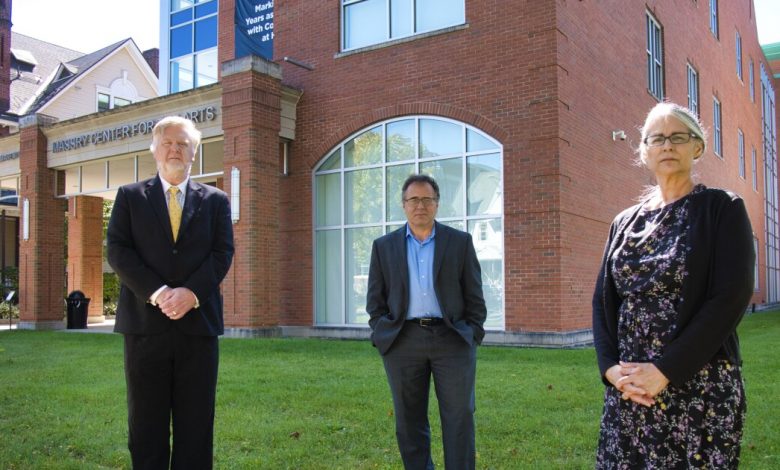These Tenured Professors Were Laid Off. Here’s How They Got Their Jobs Back.

In a rare legal victory for tenured faculty members who get laid off, a state supreme court awarded four professors their jobs back — a decision the professors say is a victory for the sanctity of tenure.
The College of Saint Rose, in Albany, N.Y., told the professors — all longtime members of the music department — in December 2020 that they would be laid off one year later, along with about 30 other tenured faculty members, as part of a cost-cutting plan that included eliminating 25 academic programs and $5.97 million in academic expenses. Those cuts were in part determined based on budget-reduction proposals submitted by each department in the college.
We see the news. We’re not the only college where this has happened.
But in terminating Yvonne Chavez Hansbrough, Robert S. Hansbrough, Bruce C. Roter, and Sherwood W. Wise, Saint Rose violated its own faculty manual, Justice Peter A. Lynch of the Supreme Court for the County of Albany found in a ruling last month. The college had kept intact the jobs of less-senior faculty members in what the justice called a “select, narrow, and erroneous interpretation” of the faculty manual, seemingly “by design.”
Wise, the music department’s chair, had proposed more than $500,000 in cuts, according to documents filed in the lawsuit. But a joint working group of faculty and administrators reviewing the budget-reduction proposals ultimately adopted a different set of cuts — ones influenced, the lawsuit alleges, by a secret counterproposal Wise and the other plaintiffs knew nothing about.
The secret proposal, which was submitted several weeks past the deadline, came from a group of faculty members who taught in Saint Rose’s music-industry concentration. (Not an official program or major, the concentration focuses on commercial music production and management, while the department’s other offerings are dedicated to performance and music education.) According to the lawsuit, the music-industry faculty members’ plan called for the entire music program to be eliminated except for their concentration and its faculty members — the lawsuit’s plaintiffs not among them.
That the counterproposal was allowed to be submitted at all was “patently unfair,” Roter told The Chronicle, and “corrupted the entire retrenchment process.” Indeed, the lawsuit says that Wise, as chair, wasn’t given the opportunity to respond to that proposal. With one exception, none of the music-industry professors being kept on were as senior as any of the laid-off faculty members; the lawsuit argues that violated Saint Rose’s faculty manual, which requires the college to give preference to faculty members based first on tenure, then seniority, then rank.
There had long been friction between music-industry faculty members and the broader music department, Margaret T. McLane, the provost, wrote in an affidavit. “The curriculum in the three eliminated music programs has been criticized by certain current and former members of our campus community as being ‘too white,’” McLane wrote. “That is, the three eliminated music programs tend to focus on classical music, whereas the music-industry program focuses on more contemporary, and more diverse, music genres.”
The suing professors take issue with those statements, especially coupled with statistical discrepancies they outlined in the lawsuit. Some of the enrollment and financial data on which the cuts were based were inaccurate or outdated, they argued, and the music-education program that was designated for elimination was more profitable than the music-industry concentration. “One could think that the administration was not only conflating an economically driven retrenchment process but also had certain programmatic agendas in mind,” Roter said.
On those grounds and others, including a lack of due process, the plaintiffs and several colleagues appealed their terminations to an internal review committee, which ruled in their favor and recommended their reinstatement. But Marcia J. White, then the college’s interim president, rejected the appeal, prompting the four professors to take their case to court.
Achieving legal recourse in tenure-revocation cases is often an uphill battle, as the professors’ lawyer, Meredith Moriarty, acknowledged. “The standards are pretty high,” Moriarty, of the New York-based law firm Smith Hoke PLLC, told The Chronicle. “A college does have a lot of freedom to conduct its affairs. However, it doesn’t have complete freedom, and it does have to follow the faculty manual.”
The court concurred, with Justice Lynch writing that the college did not follow its faculty manual’s order of preference and that its “actions cannot stand!”
The four professors plan to return to teaching this spring, but their longer-term future is uncertain. White, now the president, said in a message to the campus community that Saint Rose would appeal the court’s decision, writing that “until the matter can be heard by the appellate court, the college will comply with the court’s decision in this employment matter.” Citing the appeal, White declined an interview with The Chronicle.
‘Good for All Tenured Faculty’
Saint Rose has laid off tenured professors before. In 2015 it slashed 14 tenured appointments and 27 academic programs, leading the American Association of University Professors to investigate the college and censure it in 2016.
Shortly after the four professors received their notices, they retained Moriarty’s firm. They also contacted the AAUP, whose power to intervene was limited. “When an institution is on our censure list, we’ve essentially fired our biggest gun, as it were,” said Gregory F. Scholtz, director of the AAUP’s department of academic freedom, tenure, and governance. Scholtz and the association sent the college a letter registering concern. Saint Rose had acted against the AAUP’s widely adopted Statement of Principles on Academic Freedom and Tenure, Scholtz wrote, by not declaring financial exigency before laying off tenured faculty members. (Doing so, McLane’s affidavit reads, “would be counterproductive, and would likely result in further enrollment decline and other adverse impacts to the College.)
And while Saint Rose’s faculty manual permits the college to terminate tenured faculty members because of “anticipated program reductions,” Scholtz wrote in the letter that “the AAUP does not regard the mere anticipation of program reductions as a legitimate basis” for laying off tenured faculty. For that reason, the association — though not the court — viewed the layoffs as “completely illegitimate from the beginning,” Scholtz said.
That the court’s ruling affirmed the contractual nature of Saint Rose’s faculty manual is significant, Scholtz said. “It was heartening for us to see that the Supreme Court in New York said, ‘Yeah, faculty handbooks do matter and they should be followed not just by the faculty, but by the administration as well.’”
That declaration bodes well for the state of academic freedom and tenure writ large, Scholtz and the reinstated music professors said.
“We see the news. We’re not the only college where this has happened,” Chavez Hansbrough said. “I always felt, ‘Well, we’re doing this for us, for our students, for all of our colleagues who got fired, but also for all tenured faculty across the nation.’
“If we prevail and we win to the end, I think it’s good for all tenured faculty.”
Source link






